CD, CD Çalar, DVD, DVD Çalar, SACD, LP, Plak Çeşitleri ve Fiyatları
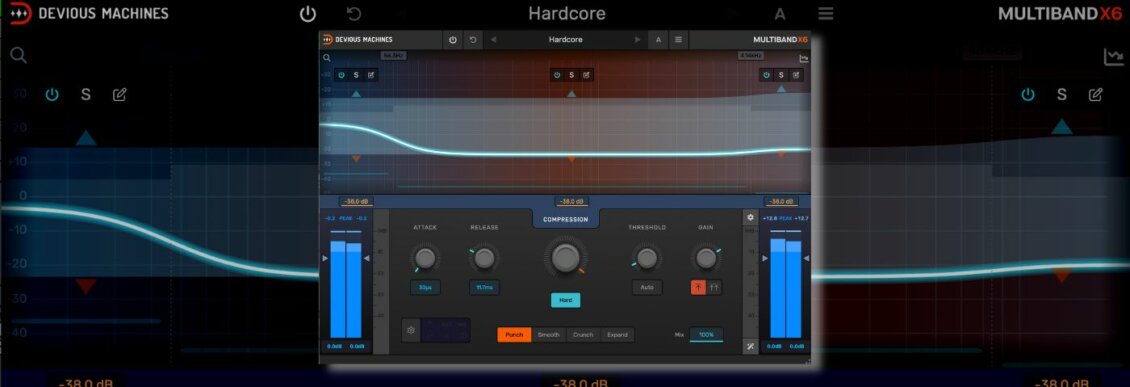
“Where should I use multiband compression?” is a common question we receive. We’re going to show you how to use multiband compression with the help of Devious Machines Multiband X6 – a new tool that simplifies it, and sounds great to boot.
Music producers have to wear a lot of different hats. We need to be able to compose music, arrange songs, mix everything down and then master it. These all used to be separate job descriptions! So it pays to know how to use multiband compression as its uses are wide-ranging.
It makes sense then that we’ll sometimes want a plugin that does some of the heavy lifting for us. This is especially true when the lifting in question is multiband compression, a dynamics technique that can deliver incredible results but, if you’re not careful, can also ruin all of your hard work.
Enter Devious Machines Multiband X6, a multiband compression plugin designed to make it easy to understand for beginners. That it does, with a number of intuitive features that go a long way towards letting you get past the hard part and straight to mixing your music. It also sounds incredible.
If you want to follow along with the examples, you can download the demo for free.
[advert]
What Is Multiband Compression And How Do I Use It?
Traditional compressors apply dynamics equally across the frequency spectrum. Multiband compressors, however, allow you to split the frequencies into discrete bands and compress each one independently.
This can involve more than just how much you compress but also things like threshold, attack and release settings, and more. It offers incredible flexibility and provides a way for you to dial in your dynamics surgically, like an EQ.
You can use multiband compression on any audio source but it’s most effective on full-frequency content like drums, synth pads or even finished songs. Basically, any audio with a wide frequency spread can benefit from multiband compression. With such precise control, you can achieve tight and in-your-face sounds quickly and in a few steps.
[quote align=right text=”Multiband compressors, however, allow you to split the frequencies into discrete bands and compress each one independently.”]
The Benefits Of Multiband X6
Multiband compression, when done correctly, can sound amazing. If you don’t know what you’re doing, however, you may find your mix overcooked and blown out.
Devious Machines have thus designed Multiband X6 specifically for people who may have never used a multiband compressor before. If you already know a little about regular compressors, you’ll have no trouble diving into X6. Just think of it as six separate frequency-specific compressors with top-level macro controls. You can even use it as a single, wideband compressor if you like.
Overview of Multiband X6 Features
At first glance, Multiband X6 looks much like any other modern compressor you may have used. There are visual similarities with the popular FabFilter Pro-MB for example, but the learning curve is less steep.
There are Attack and Release controls plus Threshold and Gain knobs. There’s also an overall Compression knob, which you turn clockwise to increase gain reduction. Turn these to affect the overall sound. So far so good.
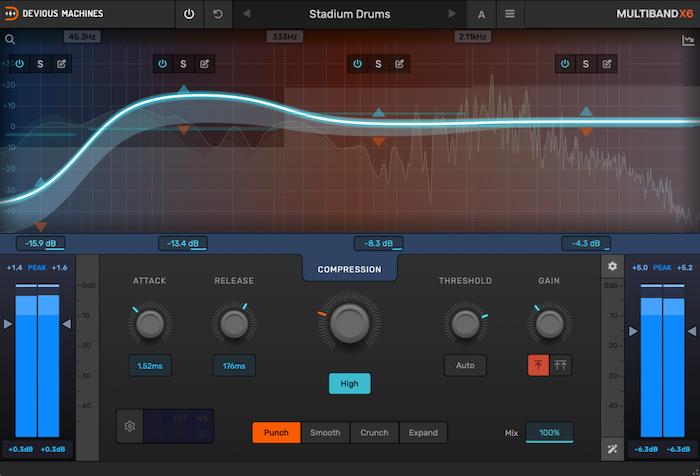
What’s different though is the way that you apply compression. The audio signal is represented as a dynamic audio wave in the window in the middle of the GUI. There are individual bands here, which can be controlled separately. You can change the size of each band by dragging the crossover point sideways. You can even adjust the crossover slope. Each band also has its own bypass, solo and edit controls; press the band edit button to adjust its individual parameters.
Compressor Types On Multiband X6
There are three compression types, including Punch, Smooth, and Crunch, plus an expander (see below for more). Each type affects and colors the sound differently. They’re all musical and extremely useful.
X6 has a number of features that make dialing in appropriate levels of multiband compression easy for newbies. We particularly like the auto-threshold mode, which analyzes the sound across bands before setting the threshold for you. There’s also an auto-level matching function to balance audio levels between compressed and bypassed signals so you don’t get tricked by your ears into thinking the compressed signal is better just because it’s louder.
Multiband X6 may be beginner-friendly but it’s also a fully featured compressor in its own right. For more advanced features, hit the gear icon in the lower left corner. This brings up the sidechain section, with both internal and external sidechain modes. Interestingly, each of these also has wide and multiband settings, allowing you to fine-tune how the sidechain behaves. There are also stereo and mid/side modes plus oversampling, lookahead and an option to change to a linear phase crossover mode.
There’s more of course, including input and output meters, a mix amount for in-plugin parallel compression and even a frequency tilt function to increase parameter changes at the high or low end of the spectrum.
[advert]
Devious Machines Multiband X6 In Action
To get a sense of how Multiband X6 works (and sounds!), let’s put it through its paces in a few different scenarios. We recommend listening through headphones or good monitors as some of the results are subtle.
On The Master
Multiband compression can be an excellent tool on the master channel. If you are looking to control large frequency bands at once, then it’s the tool for you.
Here is our track without X6 on the master channel:
And here it is with X6 applied (no other plugins or processing on the master channel):
To achieve the result we loaded up the INIT sitting and compressed heavily in the low frequencies, upper mids and top end. These are pretty extreme settings but they are for the purpose of demonstration!
If the settings are extreme, why do we want to use a multiband compressor in audio mastering? X6 will give you more control over the dynamics of the audio signal. I.E. you can process the low end of the mix without even touching the individual parts, say cymbal or hi-hat or snare.
So, yes, you can use it on individual instruments, but it’s really great at adding that extra 1% that can make all the difference.
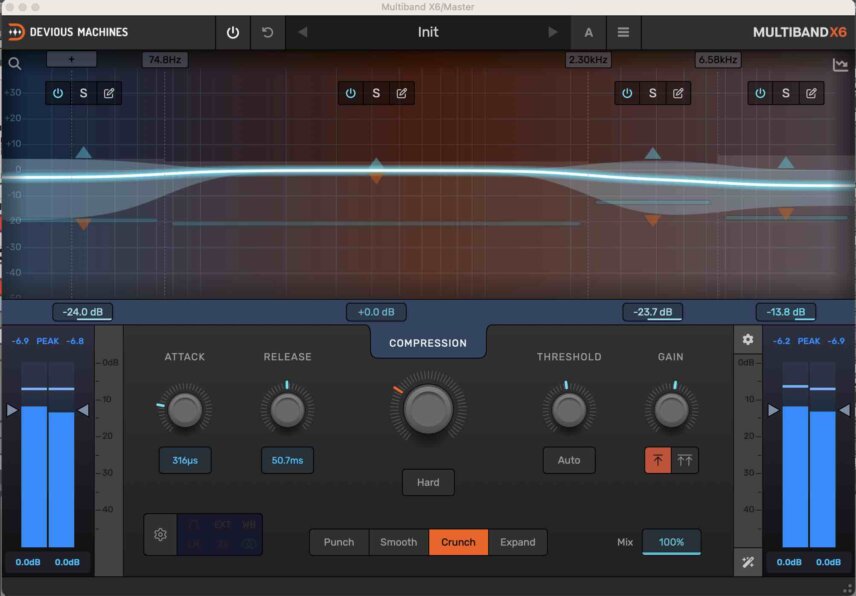
Drum Bus Weight
The drum bus is an ideal candidate for multiband compression. Here, we’ve got two drum loops. By placing Multiband X6 on the drum bus, we’re able to not only apply different compression to three bands, adding weight, power and size but also cut the low subs entirely like a shelf EQ by tuning down its gain.
The drum bus before X6:
And after:
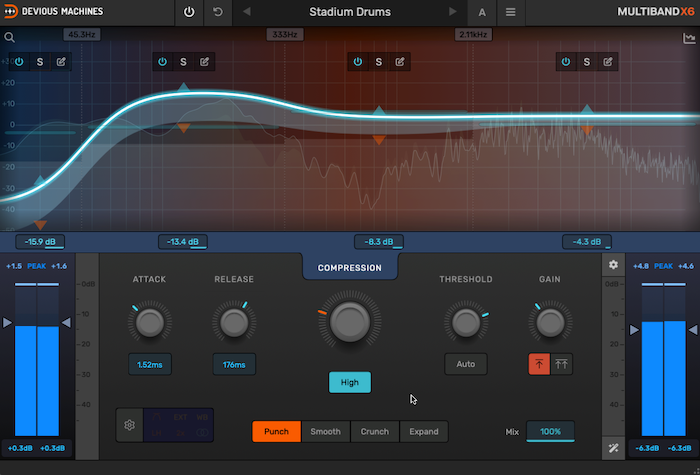
[advert]
Bassline Power
This bassline has zero power. By applying varying amounts of compression across different bands as well as removing the unnecessary low subs, Multiband X6 has given it new life.
Bassline without multiband compression:
And with multiband compression:
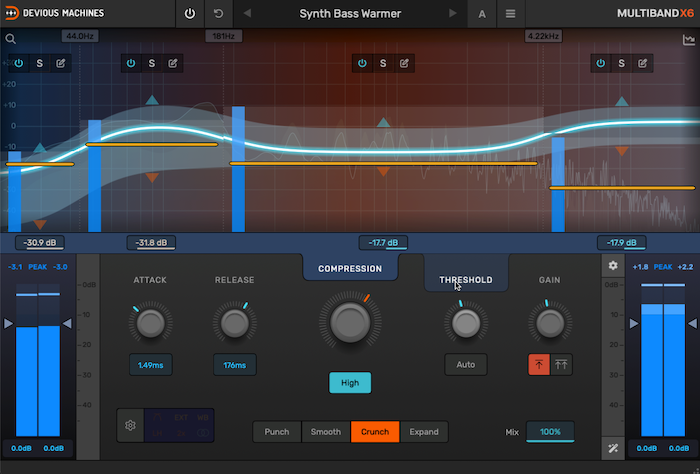
Wideband Guitar Presence
As we mentioned before, you can use Multiband X6 as a wideband compressor. This is useful for things like vocals and guitar. Here we have X6 adding presence and body to a recording of an acoustic guitar in single-band mode.
The guitar as is:
And with multiband compression:
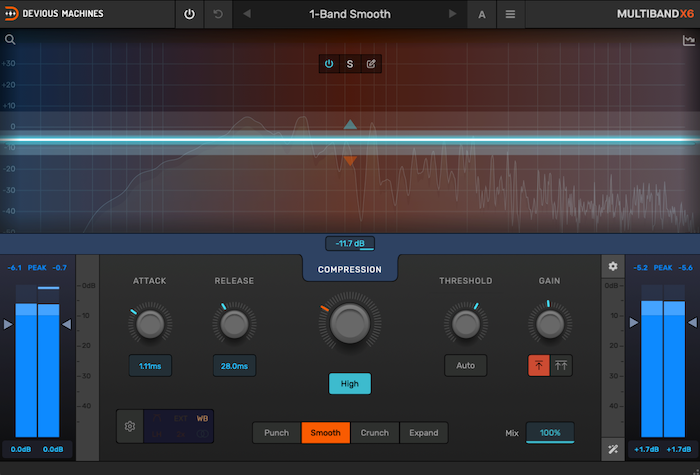
[quote align=right text=”An expander is like a reverse compressor. Instead of lowering the volume of a signal that passes above a threshold, an expander raises the volume of any sound crossing the threshold and lowering everything else.”]
Wideband Guitar Pick Reducer
Another application for wideband mode is getting rid of excessive pick noise in a guitar track. To achieve this, you can activate the internal sidechain set to wideband mode and use the internal EQ to target the frequencies of the errant pick sound. Click on the headphone icon to hear the sidechain signal in isolation to really home in on it.
Here is the original guitar audio without wideband compression:
And now with:
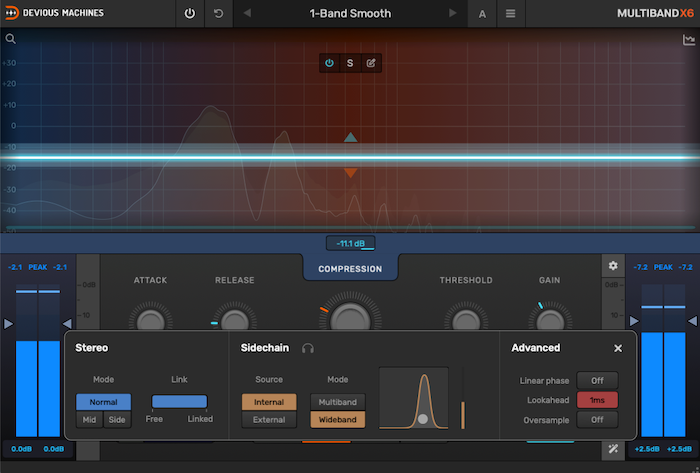
Kick Bass Glue
This is great fun.
With its external sidechain setting, you can use Multiband X6 to duck an audio signal in response to a separate track, such as to push a bassline out of the way to make room for a kick. Much tighter!
Kick and bass with no sidechaning:
Kick and bass sidechained using X6:
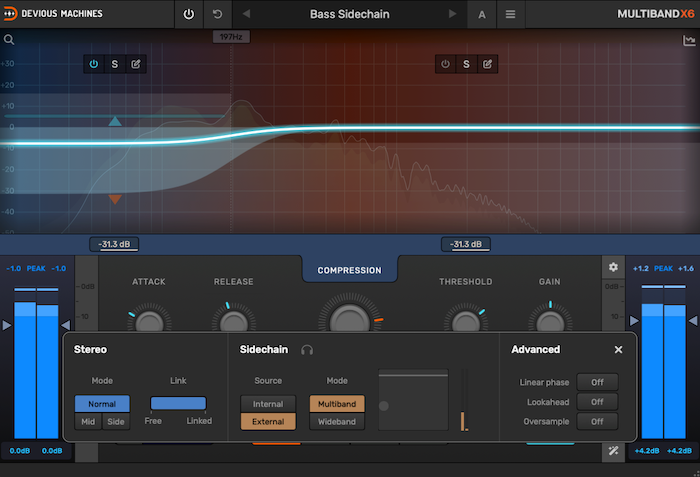
Expander Gating
We have yet to touch on Multiband X6’s expander section so let’s do that now. An expander is like a reverse compressor. Instead of lowering the volume of a signal that passes above a threshold, an expander raises the volume of any sound crossing the threshold and lowering everything else. When used with an external sidechain signal, this creates rhythmic pumping and sounds great on pads.
Ambient pads with no expansion:
And with expansion:
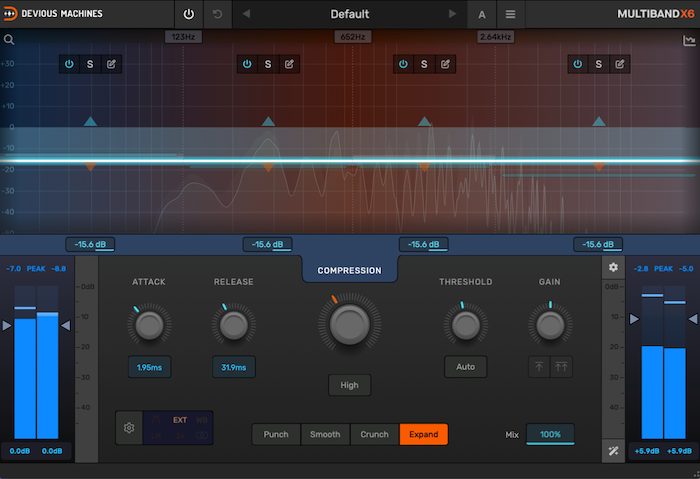
The Final Word
Devious Machines Multiband X6 is an all-around solid multiband compression package. The beginner-friendly features are sure to be a Godsend for newbies, with the auto parameters helping ensure that sounds don’t get overcooked.
Thankfully, it’s also a full-featured compressor so veteran mix engineers will feel right at home. Some plugins aimed at beginners hide the advanced stuff under the hood but Multiband X6 strikes a good balance of being both easy to use and capable of professional-level work.
The obvious competitor for Multiband X6 is FabFilter’s Pro-MB. At £144, it’s significantly more expensive than the £79 Devious Machines Multiband X6. X6’s price will certainly be attractive to beginners looking to get their feet wet with multiband compression, or with experienced producers hankering for a fun new dynamics plugin.
Yes, Devious Machines Multiband X6 is fun, which is something you don’t often say about compressors of any kind. They’re tools, and like a hammer, you probably wouldn’t take to Twitter to tell everyone how fun your latest is. However, Multiband X6 is the exception to this rule. It’s a blast to use, delivers great results quickly, and sounds fantastic.
Devious Machines Multiband X6 is out now priced at £79.99. There is a demo option available also.
Works with:
- OSX 10.11 or later; Windows 10 or later.
- VST 2, VST 3, AudioUnit and Protools 64-bit AAX
- Native Apple Silicon support.
[social-links heading=”Follow Attack Magazine” facebook=”https://www.facebook.com/attackmag” twitter=”https://twitter.com/attackmag1″ instagram=”https://www.instagram.com/attackmag/” youtube=”https://www.youtube.com/user/attackmag” soundcloud=”https://soundcloud.com/attackmag” tiktok=”https://www.tiktok.com/@attackmagazine”]
attackmagazine

“Where should I use multiband compression?” is a common question we receive. We’re going to show you how to use multiband compression with the help of Devious Machines Multiband X6 – a new tool that simplifies it, and sounds great to boot.
Music producers have to wear a lot of different hats. We need to be able to compose music, arrange songs, mix everything down and then master it. These all used to be separate job descriptions! So it pays to know how to use multiband compression as its uses are wide-ranging.
It makes sense then that we’ll sometimes want a plugin that does some of the heavy lifting for us. This is especially true when the lifting in question is multiband compression, a dynamics technique that can deliver incredible results but, if you’re not careful, can also ruin all of your hard work.
Enter Devious Machines Multiband X6, a multiband compression plugin designed to make it easy to understand for beginners. That it does, with a number of intuitive features that go a long way towards letting you get past the hard part and straight to mixing your music. It also sounds incredible.
If you want to follow along with the examples, you can download the demo for free.
[advert]
What Is Multiband Compression And How Do I Use It?
Traditional compressors apply dynamics equally across the frequency spectrum. Multiband compressors, however, allow you to split the frequencies into discrete bands and compress each one independently.
This can involve more than just how much you compress but also things like threshold, attack and release settings, and more. It offers incredible flexibility and provides a way for you to dial in your dynamics surgically, like an EQ.
You can use multiband compression on any audio source but it’s most effective on full-frequency content like drums, synth pads or even finished songs. Basically, any audio with a wide frequency spread can benefit from multiband compression. With such precise control, you can achieve tight and in-your-face sounds quickly and in a few steps.
[quote align=right text=”Multiband compressors, however, allow you to split the frequencies into discrete bands and compress each one independently.”]
The Benefits Of Multiband X6
Multiband compression, when done correctly, can sound amazing. If you don’t know what you’re doing, however, you may find your mix overcooked and blown out.
Devious Machines have thus designed Multiband X6 specifically for people who may have never used a multiband compressor before. If you already know a little about regular compressors, you’ll have no trouble diving into X6. Just think of it as six separate frequency-specific compressors with top-level macro controls. You can even use it as a single, wideband compressor if you like.
Overview of Multiband X6 Features
At first glance, Multiband X6 looks much like any other modern compressor you may have used. There are visual similarities with the popular FabFilter Pro-MB for example, but the learning curve is less steep.
There are Attack and Release controls plus Threshold and Gain knobs. There’s also an overall Compression knob, which you turn clockwise to increase gain reduction. Turn these to affect the overall sound. So far so good.
What’s different though is the way that you apply compression. The audio signal is represented as a dynamic audio wave in the window in the middle of the GUI. There are individual bands here, which can be controlled separately. You can change the size of each band by dragging the crossover point sideways. You can even adjust the crossover slope. Each band also has its own bypass, solo and edit controls; press the band edit button to adjust its individual parameters.
Compressor Types On Multiband X6
There are three compression types, including Punch, Smooth, and Crunch, plus an expander (see below for more). Each type affects and colors the sound differently. They’re all musical and extremely useful.
X6 has a number of features that make dialing in appropriate levels of multiband compression easy for newbies. We particularly like the auto-threshold mode, which analyzes the sound across bands before setting the threshold for you. There’s also an auto-level matching function to balance audio levels between compressed and bypassed signals so you don’t get tricked by your ears into thinking the compressed signal is better just because it’s louder.
Multiband X6 may be beginner-friendly but it’s also a fully featured compressor in its own right. For more advanced features, hit the gear icon in the lower left corner. This brings up the sidechain section, with both internal and external sidechain modes. Interestingly, each of these also has wide and multiband settings, allowing you to fine-tune how the sidechain behaves. There are also stereo and mid/side modes plus oversampling, lookahead and an option to change to a linear phase crossover mode.
There’s more of course, including input and output meters, a mix amount for in-plugin parallel compression and even a frequency tilt function to increase parameter changes at the high or low end of the spectrum.
[advert]
Devious Machines Multiband X6 In Action
To get a sense of how Multiband X6 works (and sounds!), let’s put it through its paces in a few different scenarios. We recommend listening through headphones or good monitors as some of the results are subtle.
On The Master
Multiband compression can be an excellent tool on the master channel. If you are looking to control large frequency bands at once, then it’s the tool for you.
Here is our track without X6 on the master channel:
And here it is with X6 applied (no other plugins or processing on the master channel):
To achieve the result we loaded up the INIT sitting and compressed heavily in the low frequencies, upper mids and top end. These are pretty extreme settings but they are for the purpose of demonstration!
If the settings are extreme, why do we want to use a multiband compressor in audio mastering? X6 will give you more control over the dynamics of the audio signal. I.E. you can process the low end of the mix without even touching the individual parts, say cymbal or hi-hat or snare.
So, yes, you can use it on individual instruments, but it’s really great at adding that extra 1% that can make all the difference.

Drum Bus Weight
The drum bus is an ideal candidate for multiband compression. Here, we’ve got two drum loops. By placing Multiband X6 on the drum bus, we’re able to not only apply different compression to three bands, adding weight, power and size but also cut the low subs entirely like a shelf EQ by tuning down its gain.
The drum bus before X6:
And after:
[advert]
Bassline Power
This bassline has zero power. By applying varying amounts of compression across different bands as well as removing the unnecessary low subs, Multiband X6 has given it new life.
Bassline without multiband compression:
And with multiband compression:
Wideband Guitar Presence
As we mentioned before, you can use Multiband X6 as a wideband compressor. This is useful for things like vocals and guitar. Here we have X6 adding presence and body to a recording of an acoustic guitar in single-band mode.
The guitar as is:
And with multiband compression:
[quote align=right text=”An expander is like a reverse compressor. Instead of lowering the volume of a signal that passes above a threshold, an expander raises the volume of any sound crossing the threshold and lowering everything else.”]
Wideband Guitar Pick Reducer
Another application for wideband mode is getting rid of excessive pick noise in a guitar track. To achieve this, you can activate the internal sidechain set to wideband mode and use the internal EQ to target the frequencies of the errant pick sound. Click on the headphone icon to hear the sidechain signal in isolation to really home in on it.
Here is the original guitar audio without wideband compression:
And now with:
Kick Bass Glue
This is great fun.
With its external sidechain setting, you can use Multiband X6 to duck an audio signal in response to a separate track, such as to push a bassline out of the way to make room for a kick. Much tighter!
Kick and bass with no sidechaning:
Kick and bass sidechained using X6:
Expander Gating
We have yet to touch on Multiband X6’s expander section so let’s do that now. An expander is like a reverse compressor. Instead of lowering the volume of a signal that passes above a threshold, an expander raises the volume of any sound crossing the threshold and lowering everything else. When used with an external sidechain signal, this creates rhythmic pumping and sounds great on pads.
Ambient pads with no expansion:
And with expansion:
The Final Word
Devious Machines Multiband X6 is an all-around solid multiband compression package. The beginner-friendly features are sure to be a Godsend for newbies, with the auto parameters helping ensure that sounds don’t get overcooked.
Thankfully, it’s also a full-featured compressor so veteran mix engineers will feel right at home. Some plugins aimed at beginners hide the advanced stuff under the hood but Multiband X6 strikes a good balance of being both easy to use and capable of professional-level work.
The obvious competitor for Multiband X6 is FabFilter’s Pro-MB. At £144, it’s significantly more expensive than the £79 Devious Machines Multiband X6. X6’s price will certainly be attractive to beginners looking to get their feet wet with multiband compression, or with experienced producers hankering for a fun new dynamics plugin.
Yes, Devious Machines Multiband X6 is fun, which is something you don’t often say about compressors of any kind. They’re tools, and like a hammer, you probably wouldn’t take to Twitter to tell everyone how fun your latest is. However, Multiband X6 is the exception to this rule. It’s a blast to use, delivers great results quickly, and sounds fantastic.
Devious Machines Multiband X6 is out now priced at £79.99. There is a demo option available also.
Works with:
- OSX 10.11 or later; Windows 10 or later.
- VST 2, VST 3, AudioUnit and Protools 64-bit AAX
- Native Apple Silicon support.
[social-links heading=”Follow Attack Magazine” facebook=”https://www.facebook.com/attackmag” twitter=”https://twitter.com/attackmag1″ instagram=”https://www.instagram.com/attackmag/” youtube=”https://www.youtube.com/user/attackmag” soundcloud=”https://soundcloud.com/attackmag” tiktok=”https://www.tiktok.com/@attackmagazine”]